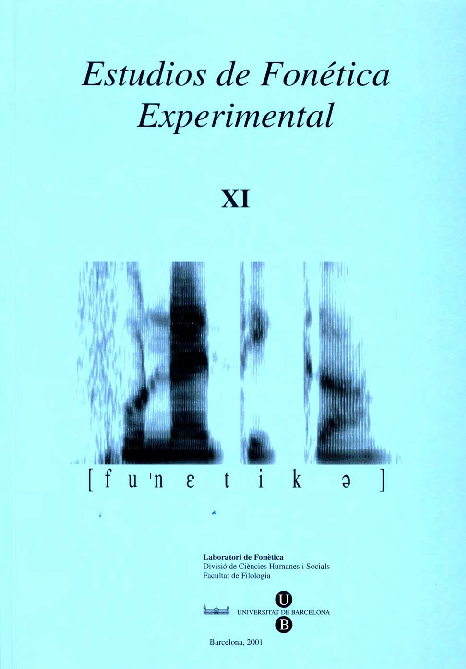Clash silábico y desplazamiento acentual en el español canario
Abstract
Syllabic clash takes place when two or more strong syllables are in succession or in vicinity in a spoken sequence. For example, in English thir´teen ´men, ´three ´red ´shirts, in Spanish pri´mer ´niño, ´tu ´das ´todo, in Swedish Kap´ten ´Andersson, and so forth in many languages. Phonetic and phonological studies have considered that sequences like these are cacophonous or not natural. For that reason speakers of any language have an entire series of resources dedicated to avoid them: stress shift, lengthening or reduction of one of the stressed syllables, insertion of a pause between the strong syllables, etc.
The purpose of this study is to check the use of stress shift as a way of avoiding the clash in the Canarian Spanish speech. Acoustical cues analyzed were time, pitch and intensity. Values obtained were subjected to a statistical treatment (analysis of Anova).
References
ALMEIDA, M. (1991): «Organización del ritmo en español», Revista Argentina de Lingüística, 7, pp. 5-19.
ALMEIDA, M. (1993): «Alternancia temporal y ritmo en español», Verba, 20, pp. 433-443.
ALMEIDA, M. (1999): Tiempo y ritmo en el español canario. Un estudio acústico, Madrid, Iberoamericana/ Frankfurt am Mein, Vervuert.
ALMEIDA, M. y E. SAN JUAN (1999): «Alternancia y ritmo en español: el clash silábico», en Actes del I Congrés de Fonètica Experimental, Tarragona, Universitat Rovira i Virgili/ Universitat de Barcelona, pp. 105-110.
ALMEIDA, M. Y G. A. TOLEDO (1997): «Alternancia del ritmo en español», en Almeida y Dorta (eds.), Contribuciones al estudio de la Lingüística Hispánica, Barcelona, Montesinos, pp. 35-41.
BOLINGER, D. L. (1965): «Pitch accent and sentence rhythm», en Abe y Kanekiyo (eds.), Forms of English: accent, morpheme, order, Cambridge, Harvard University Press, pp. 139-180.
BRUCE, G. (1983): «On rhythmic alternation», Working Papers, 25, Lund, Lund University, Department of Linguistics and Phonetics, pp. 35-52.
DI CRISTO, A. y D. HIRST (1993): «Rythme syllabique, rythme mélodique et représentation hiérarchique de la prosodie du français», Travaux de l'Institute de Phonétique d'Aix, 15, pp. 25-42.
DELATTRE, P. (1966): «A comparison of syllable length conditioning among languages», International Review of Applied Linguistics, 4, pp. 183-198.
FARNETANI, E. y S. KORI (1981): «Italian lexical stress in connected speech», en Proceedings of the 4th FASE Symposium on Acoustics and Speech, 1, Roma, Edizioni Scientifiche Associate, pp. 53-56.
GARCÍA CALVO, A. (1975/ 1989): «Del ritmo del lenguaje», en Hablando de lo que habla (Estudios de lenguaje), Madrid, Lucina,, 1989, pp. 303-386 (Reedición del libro Del ritmo del lenguaje, 1975).
GILI GAYA, S. (1940/41): «La cantidad silábica en la frase», Castilla 1, pp. 287-298.
HALLE, M. y J.R. VERGNAUD (1990): An essay on stress, Cambridge, The M. I. T. Press.
HAYES, B. (1983): «A grid-based theory of English meter», Linguistic Inquiry, 14, pp. 357-393.
HAYES, B. (1984): «The phonology of rhythm in English», Linguistic Inquiry, 15, pp. 33-74.
VAN HEUVEN, V. J. (1987): «Stress patterns in Dutch (compound) adjectives: acoustic measurements and perception data», Phonetica, 44, pp. 1-12.
KIPARSKY, P. (1979): «Metrical structure assignement is cyclic», Linguistic Inquiry, 10, pp. 421-441.
MAJOR, R. C. (1985): «Stress and rhythm in Brazilian Portuguese», Language, 61, pp. 259-282.
NESPOR, M. e I. VOGEL (1979): «Clash avoidance in Italian», Linguistic Inquiry, 10, pp. 467-482.
OLSEN, C. L. (1972): «Rhythmical patterns and syllabic features of the Spanish sense-group», en Rigault y Charbonneau (eds.), Proceedings of the Seventh International Congress of Phonetic Sciences, The Hague, Mouton, pp. 990-996.
PAMIES BERTRÁN, A. (1994): «Los acentos contiguos en español», Estudios de Fonética Experimental, VI, pp. 91-111.
PRINCE, A. S. (1983): «Relating to the grid», Linguistic Inquiry, 14, pp. 19-100.
SELKIRK, E. O. (1984): Phonology and syntax: the relation between sound and structure, Cambridge, The M.I.T. Press.
TOLEDO, G. A. (1988): El ritmo en el español. Estudio fonético con base computacional, Madrid, Gredos.
TOLEDO, G. A. (1997): «Prominencia melódica y temporal: la colisión acentual en español», Estudios de Fonética Experimental, IX, pp. 201-219.
Downloads
Published
How to Cite
Issue
Section
License

This work is licensed under a Creative Commons Attribution-NonCommercial-NoDerivatives 4.0 International License.
All articles published online by Estudios de Fonética Experimental are licensed under Creative Commons Attribution-NonCommercial-NoDerivs 4.0 International (CC BY-NC-ND 4.0 DEED), unless otherwise noted. Estudios de Fonética Experimental is an open access journal. Estudios de Fonética Experimental is hosted by RCUB (Revistes Científiques de la Universitat de Barcelona), powered by Open Journal Systems (OJS) software. The copyright is not transferred to the journal: authors hold the copyright and publishing rights without restrictions. The author is free to use and distribute pre and post-prints versions of his/her article. However, preprint versions are regarded as a work-in-progress version used as internal communication with the authors, and we prefer to share postprint versions.




